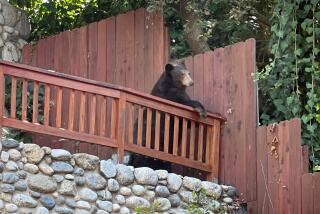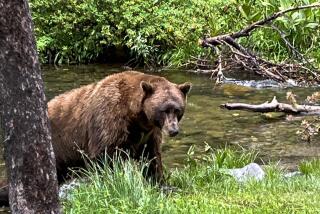A Bear’s Best Friend : Timothy Treadwell says a grizzly saved his life--so he is trying to return the favor. Armed with photos and lectures, he has dedicated himself to their preservation.
- Share via
Timothy Treadwell had a hangover. Again. So, as he’d done countless times before, he drove to an isolated spot in the wilderness--this time Wrangell-St. Elias National Preserve in Alaska--and hiked into the woods to dry out.
“Nothing could ever get me to stop drinking,” he says now, seven years later, while downing his second Coca-Cola in as many minutes. “Some people find religion, some have a child and find a greater purpose in their lives.”
But Treadwell felt doomed to live a short life of drinking, dodging barroom brawls and drying out from time to time in the woods.
Then, while trudging alone through the wild beauty of the preserve, something unexpected happened.
“All of a sudden a big, gorgeous bear, four or five hundred pounds, came crashing through the woods.”
It froze at the sight of Treadwell and then, before he had the chance to back away, bounded majestically back into the woods.
“It was a fleeting moment that was just magic,” he says, his expression turning dreamy.
Since then, Treadwell, 32, has become an expert on the world’s largest terrestrial carnivore, the Alaskan grizzly, which can weigh 1,500 pounds and kill a person with a single swipe of its massive paw.
Each year, just as the bears emerge from their dens, scruffy, hungry and a little grumpy after a long winter of isolation, Treadwell flies to a remote region of Alaska, sets up a tent, pulls out his camera and hunkers down for weeks.
“I get on their level. You have to get as wild as them as quickly as possible. I chomp on the grass here and there and hope I’m accepted.”
When he’s not out pawing the earth and snapping photographs, Treadwell spends his winters in Malibu where, between waiting tables, he tirelessly promotes the preservation of the grizzlies by showing his slides to schoolchildren and adults. In April, he signed a deal with Audubon Productions and Turner Broadcasting to be featured in a film called “The Man Who Loves Bears,” slated to begin production this summer.
“The bears saved my life,” he says, adding without irony: “I’d be willing to die for them.”
His one-room Malibu apartment is covered from wall to wall with close-range photographs of the bears--candid pictures that reflect Treadwell’s intimacy with his subjects. Like a proud parent, he points them out one by one.
“That’s Booble. There’s Snowy. Over there, that’s Aqua Bear.” His sentences run into each other like a train wreck as he bounds happily through the room.
*
Environmental brochures and newspaper articles on bear poaching take up the space not used by his photographs. Once in awhile a horse from a nearby barn pops its head into the bathroom window and, without breaking stride, Treadwell feeds it an apple. Except for a few modern amenities--MTV, a small refrigerator, an answering machine--the place has the dank, cavernous feel of a bear’s lair.
“There’s a spirituality to this. I don’t deny a God, but I don’t see the standard God, the Christian God and all the Allahs. . . . When you are with a grizzly bear, up close, and you hear them breathe and you feel them move and you hear the gurgles in their stomach, you feel as if you are in the presence of a God and you must turn your life over.”
Indeed, when it comes to grizzlies, Treadwell speaks with a fiery evangelism no matter who is listening. This fervor goes over particularly well with the second-graders at John L. Webster Elementary School in Malibu.
While they watch his slides, Treadwell tells his rapt audience that once, a long time ago, Malibu was filled with grizzlies.
Despite some giggles and the animated “oohs” and “ahs” as the kids pass around some bear fur, Treadwell hammers home the notion that bears are our friends, to be respected and revered.
“We never feed wild animals. No tricks or treats. Just try to be friendly. We don’t want to take away their natural habits.”
When one small girl with big O’s for eyes asks Treadwell what he does if a bear gets mad at him, he happily replies: “I sing to it.”
*
In fact, singing is the only weapon Treadwell uses to placate a bear that exhibits any of the 21 basic warning signs of anger--signs Treadwell has carefully memorized. In one close call, Treadwell tells the class, a young male approached him with his fur raised up in angry points on his back, snarling. But Treadwell managed to pacify the animal by singing a rhyme he made up on the spot.
Remarkably, during this encounter, Treadwell maintained a steady enough hand to snap his camera. The result is a series of amazing pictures showing how the angry adversary was lullabied into passivity. In the final slide, the bear sleeps peacefully only a few feet away. And Treadwell tells the class that he felt so secure he laid down beside the bear to catch of few Zs of his own.
“Timothy is quite off the wall,” says Doug Peacock, a founding member of Earth First! “He’s an iconoclast and an outsider. His empirical observations are as good as anyone’s.”
Sterling Miller, a bear biologist for the Alaska Department of Fish and Game, agrees that “Timothy’s talks are very valuable. He’s an advocate for the bear. A vocal and I think very effective one.”
Treadwell plans to seek nonprofit status for his organization, the Great Bear Project. His goal, as the sole activist and head honcho of the project, is threefold: to protect their habitat, to end illegal poaching and to stop the practice of legal grizzly bear hunting.
“We need to raise the grizzly bear to the kindred state of the whale and dolphin,” he says.
Although Treadwell’s focus is on developing a peaceful strategy, he sees legitimacy in radical environmental groups such as Earth First! that have been criticized for resorting to violence.
But, he adds, “I think it’s better working within the system. What’s needed is education because to get results or legitimacy, you have to do it without shooting people.”
*
Nevertheless, Treadwell is often accused of being overly emotional, especially when it comes to the issue of legal sport hunting.
“Grizzly populations have been reduced primarily through destruction of habitat,” says Miller, the Alaska bear biologist. “Bears are his personal friends. Timothy is picking on an emotional issue and not on other targets that affect bear populations.”
Treadwell concedes that he is emotional and that Miller, to whom he defers in all matters involving the science of bears, is right that “habitat encroachment is the main killer of bears.”
Others express concern that Treadwell swaggers dangerously close to understating how unpredictable grizzlies can be.
“Everything I’ve heard about him sounds terrific,” says David Gaillard, project coordinator for Wild Forever--the American Grizzly Bear Project, which--in collaboration with the Sierra Club, the Audubon Society and the Greater Yellowstone Coalition--seeks to protect the grizzly from extinction. “But he needs to be careful about sending a message to the public that bears don’t pose a serious threat to human safety. Bears are not cuddly.”
Treadwell doesn’t believe he is giving the wrong message at all. He points out that the safest bear is the habituated bear, the one familiar with humans. He sees himself as a myth-breaker and wants to do away with the notion that bears are evil, terrifying creatures.
“Bears shouldn’t be able to walk up 5th and Flower, but if people would stop hurting them, they would relax more around us. To coexist peacefully with the bear, you need compassion, reason, love, nurturing, a strong feminine side.
“The only thing you get back is what you give. Which is the essence of life. When I’m with Casper or Booble, they are cuddly.”
And if he’s attacked?
“You make your bed, you lie in it,” he says without much flourish.
*
Peacock, of Earth First!, says he shares Treadwell’s passion for the bear, but he is nonetheless quick to point out that he doesn’t recommend Treadwell’s methods.
“The bears of the world don’t need thousands of Timothy Treadwells out there because sooner or later someone’s gonna get mauled and that could cause a bear to get shot.”
Just last month, a black bear was shot to death in Azusa after wandering out of the mountains and into a residential area.
Treadwell, who was filming in Alaska at the time, expressed sorrow for the bear’s death. Although he makes no bones about shooting a bear when it clearly threatens life or property, he expressed concern for what he perceived in Azusa as the possible mishandling of the situation. He sees only one positive aspect: “Maybe they learned something from it, and next time they won’t have to destroy a life.”
Last August, a 13-year-old was mauled by a black bear at a campground in the San Bernardino National Forest. Although the boy survived, he required more than 100 stitches. After another attack the next day, two bears were tracked and shot to death--standard procedure.
Treadwell is so fearful of this that he claims to have made a deal with his pilot to quietly dump his body in the ocean should he ever be found mauled to death in his secret refuge.
Not that he expects to meet such a fate. “They love me too much,” he says of the bears.
So his agenda, for now at any rate, is to stay alive long enough to complete work on his film. Due to air early in 1995 on Turner Broadcasting, the film will follow Treadwell on his Alaskan adventures, focusing on the lucrative poaching trade with its ties to China.
Liam O’Brien, the independent producer who brought Treadwell to the attention of Audubon, says that while he’s very excited about the film, he’s also a little nervous about getting so close to the bears.
O’Brien’s first impression of Treadwell was a common one: “I thought he was crazy,” he says with a respectful laugh. But his interest was piqued and he soon realized that both Treadwell and his crusade were serious.
“The bears are being poached for their gall bladders and claws. A live bear is worth nothing. But a dead bear is worth up to $40,000. It’s a Mercedes that they’re shooting.”
*
With the film in pre-production, Treadwell’s life has altered considerably. For one thing, he gets to quit waiting tables. But he also has to deal with the human world of collaboration, budgets and deal-making--a world so alien to the solitude of his Alaskan refuge that when he talks about it, he appears baffled, even dismayed.
“It’s therapeutic that other people are finding value in my work. People are giving me attention, and that’s kind of nice but that’s all about ego,” he carefully explains. To him, the only important issue is whether this unfamiliar dip into the waters of Hollywood will help his bears.
“I didn’t choose this calling,” he says. “But in the course of saving animals, you save humans. You stop being afraid of the dark. You live in mutual respect and love.”
He pauses to look at a picture of Booble digging for clams.
“And that,” he says with a satisfied smile, “is the crux of it.”
More to Read
Sign up for Essential California
The most important California stories and recommendations in your inbox every morning.
You may occasionally receive promotional content from the Los Angeles Times.










